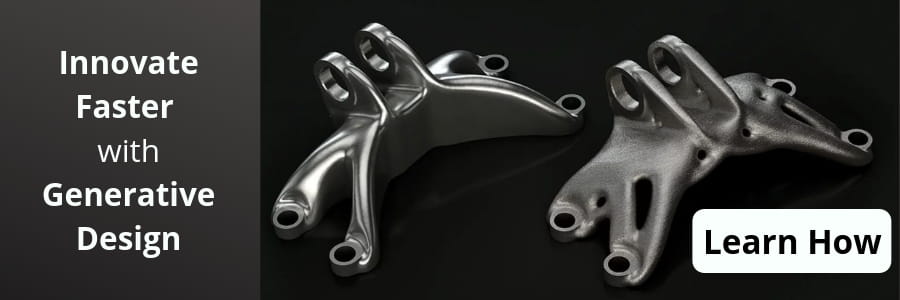Jesse Coors-Blankenship is the Senior Vice President of Technology at PTC. Former CEO of Frustum, Jesse pioneered generative design technology, utilizing artificial intelligence and new mathematical representations of geometry to make generative design functional. At PTC, he leads the effort to bring Frustum’s pioneering work in generative design to market in the CREO CAD platform. Together Frustum and PTC will transform how products are designed for a higher complexity future.
If you’re in the business of using CAD software for product design and development, you’re likely familiar with topology optimization, a way of optimizing a shape to solve for multiple functional objectives.
Topology optimization takes a 3D design space and whittles away material within it to achieve the most efficient design. The method doesn’t care about aesthetics, traditional approaches, or any other of the design constraints that you would normally use in the design phase. Instead, it produces a single optimal shape of a part or system constrained only by the available design space.
But topology optimization is not a new concept. For years, engineers have used this method to find an optimal distribution of material in a 3D model to meet their goals, such as to reduce mass, avoid a resonance mode, or minimize thermal stress or deformation.
So how are leading industrial design enterprises engineering and designing products faster and smarter in 2019? They are looking at new technology that builds on topology optimization to design the products of the future.
Enter generative design.
Generative design is a way to autonomously generate optimal designs from a set of system design requirements. With generative design, engineers can interactively specify the functional requirements and goals of their design, including preferred materials and manufacturing processes—and the generative engine will automatically produce a manufacture-ready design. The end result is being able to interact with the technology to create superior designs and innovative products more quickly.
Topology optimization and generative design have become buzzwords in the manufacturing and engineering community, but there’s a common misconception in the market that the two are synonymous. With the terms often being used interchangeably, this can create confusion and ambiguity.
Let’s take a closer look at the differences between topology optimization and generative design:
Topology Optimization Is a Foundational Technology
Since its inception in the 1990’s, topology optimization has been used to derive an optimal material distribution for a design under given functional usage conditions. It’s an algorithm that reduces the material of an existing object, allowing it to still function as per its original design intent. It has always been a tool used by stress analysts in engineering teams and not designers.
Generative design, a much newer concept, stretches the boundaries of what’s possible using technologies including topology optimization. Generative design enables the designer to make use of technologies like topology optimization. With generative design, the requirements of an imaginary design are specified —and the software will calculate all of the design possibilities that satisfy the specified requirements.
Put simply: Topology optimization converges on a single solution based only on functional objectives, constraints, and loads—solving for one solution at a time. Generative design evolves multiple solutions simultaneously to converge on the best possible set of solutions based on both functional and non-engineering requirements.
In that sense, topology optimization is a foundational technology upon which generative design is built. As engineers increasingly move product design and development into the computational realm, topology optimization serves as a “stepping stone” for generative design to get straight to the best embodiment of a design. It’s a necessary building block for generative design.
Generative Design Helps Design for the Next Generation of CAD
The development of an increasingly digital ecosystem involves investing in innovative technologies to drive business outcomes crucial to success. This includes engineering excellence, manufacturing efficiency, and product and service innovation—what PTC refers to as the three pillars of digital transformation.
For design and engineering, the impact of generative design is tremendous—improving product success rate, time to market, and time to revenue by meeting customer product needs accurately, right from the start.
In essence, generative design is reimagining the next generation of product design.
For PTC, this is accomplished, in large part, with the AI component of our generative design solution. AI aides the generative design process by evolving and ultimately augmenting human rational design capabilities. Examples include:
- Providing valuable feedback to a designer early in the design phase
- Allowing engineers at all levels to arrive at better solutions faster, driving increased productivity
- Producing designs that are optimized for efficiency and manufacturability in a way that a human designer could not easily produce
The end goal is augmented human-based product design with AI-driven generative design, enabling engineers to arrive at highly differentiated solutions previously not attainable.
Final Thoughts
While topology optimization and generative design have the same goal—namely to provide the most optimal design, given a specific set of requirements—the two technologies have distinct differences.
Generative design builds on the foundation of topology optimization to arrive at smarter, faster, and more innovative solutions. Simply put: It pushes the boundaries of what’s possible today to produce high-performing and ready to manufacture designs.
